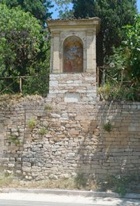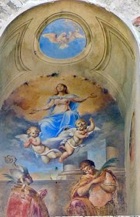Santa Barbara (1571)
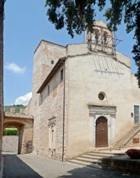
An inscription from the church, which commemorated the Emperor Augustus (27 BC - 14 AD) and which is now embedded in what remains of the Arco di Augusto, probably related to the construction of the nearby aqueduct.
Sant’ Ercolano (11th century)
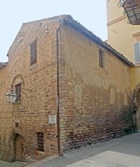
[The 8th century portal to this church survives in Via Giulia ??]
The present building was deconsecrated in 1453 when part of it was demolished to make way for the sacristy of San Lorenzo.
Relief (8th or 9th century)
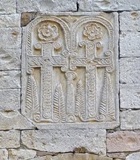
San Gregorio Magno (1573)
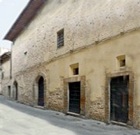
The church has a rectangular plan.
Madonna and Child with angels and saints (1587)
This altarpiece by Pierino Cesarei da Perugia, which depicts the Madonna and Child with SS Gregory and Joseph, is on the high altar. The arms suggest that the Diamanti family commissioned it.
Annunciation (1591)
This altarpiece on the Altare di San Michele on the right wall, which is dated by inscription, is attributed to Ascensidonio Spacca, il Fantino.
San Martino (12th century)
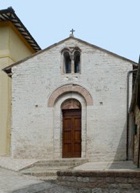
The church is in the form of a long trapezium with three crossing arches, which terminates in a semicircular apse. It was remodelled in the Baroque style in the 17th century, but was restored to its original form in 1968. The façade preserves its original portal and a bifore window above. Inside, the high altar was recomposed from original fragments in 1971, but almost all of the original fresco decoration has been destroyed.
San Rufino (ca. 1178) and San Filippo (ca. 1610)
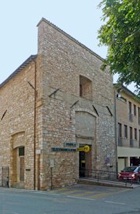
The Confraternita di San Rocco built a new church above San Rufino in ca. 1610. It was given to the Oratorian Fathers when they arrived in Spello in 1640, and they dedicated it to their founder, St Philip Neri. It then passed in succession to:
-
✴the Congregation of the Most Holy Redeemer (Redemptorist Fathers) in 1772: this congregation had been formed in 1732 by St Alphonsus Liguori;
-
✴the Seminario San Felice in 1820, at the instigation of Pope Pius VII;
-
✴the Ursuline sisters from Santa Chiara in 1822;
-
✴the Congregation of the Most Precious Blood in 1834: Pius VII had formed this congregation in 1814, after his return to Rome from exile; and
-
✴the Congregazione di Carità di Spello in 1860, after the unification of Italy.
The façade of this church survives, although the interior has been adapted to its current use as the Post Office.
San Sisto (13th century)
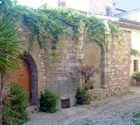
San Venanzio (12th century)
